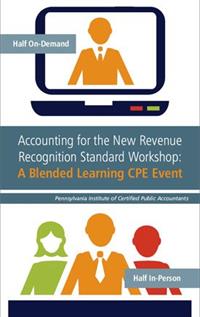Reminder: This is a reporting year! Meet your CPE requirements and make the most of your budget with PICPA’s discounted CPE bundles.
This is the archive of CPA Now blogs posted on the PICPA website through April 30, 2025. Want more recent blogs?
Get Smart: Understanding Revenue Recognition
At PICPA’s first blended learning class participants had to complete four-hours of on-demand “homework” before attending the class. This type of program allows participants to take half the class on their own time, and the other half discussing the issues with the other participants.
Apr 6, 2015, 08:43 AM
By Francesca Zampaglione, CPA, former PICPA Vice President, Professional Education
 In the beginning of the year, I posted a blog that mentioned a new type of class being offered at the PICPA: blended learning. It was not only PICPA’s first blended learning class, but also the first class of this caliber offered by any state CPA association.
In the beginning of the year, I posted a blog that mentioned a new type of class being offered at the PICPA: blended learning. It was not only PICPA’s first blended learning class, but also the first class of this caliber offered by any state CPA association.
The prerequisites for the class, which required participants to complete four-hours of on-demand “homework” before attending the class, were strictly enforced. The program allowed participants to take half the class on their own time, and the other half discussing the revenue recognition methods on-site with the other participants.
In the event that you couldn’t attend the class we held in March, we are hosting the same class in August so you too can experience this unique method of learning about revenue recognition.
If you’re on the fence, here are the top three reasons why you should attend our next blended learning revenue recognition class:
View what others had to say about the class, and I look forward to seeing you in August at our next blended learning class on revenue recognition!
 In the beginning of the year, I posted a blog that mentioned a new type of class being offered at the PICPA: blended learning. It was not only PICPA’s first blended learning class, but also the first class of this caliber offered by any state CPA association.
In the beginning of the year, I posted a blog that mentioned a new type of class being offered at the PICPA: blended learning. It was not only PICPA’s first blended learning class, but also the first class of this caliber offered by any state CPA association.The prerequisites for the class, which required participants to complete four-hours of on-demand “homework” before attending the class, were strictly enforced. The program allowed participants to take half the class on their own time, and the other half discussing the revenue recognition methods on-site with the other participants.
In the event that you couldn’t attend the class we held in March, we are hosting the same class in August so you too can experience this unique method of learning about revenue recognition.
If you’re on the fence, here are the top three reasons why you should attend our next blended learning revenue recognition class:
1. Learn from everyone in the class, not just the teacher
As I mentioned in a previous blog about revenue recognition, the devil is most certainly in the details as no one really knows how the revenue recognition standard applies to certain industries. This topic requires loads of time and energy. The blended learning class allows the teacher to serve as a facilitator and guide the brilliant discussion that emerges from everyone’s own experience and background.2. Do half the class on your schedule
Allowing class participants to decide when and where they can learn is most advantageous in a learning environment. The on-demand portion of the class allows each person to divide and conquer their learning on their own time. Nights, lunch – it’s a personal choice that works best for each participant.3. Get your money’s worth
There is an intangible element that happens in a blended learning class. Through various discussions held in class, true learning occurs; meaning that once participants leave the class they are much more knowledgeable about the topic than when they entered. The topics are bound to “stick” with them as they go back to work, and they are better able to apply the accounting standards. The exponential learning that occurs in this environment certainly makes the class valuable and provides the sense that you are getting your money’s worth.View what others had to say about the class, and I look forward to seeing you in August at our next blended learning class on revenue recognition!

